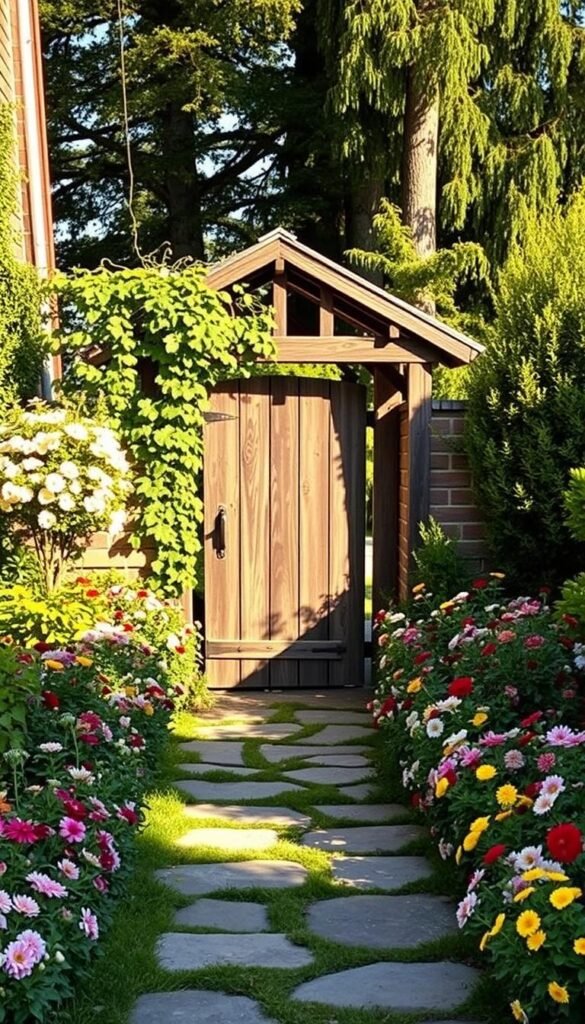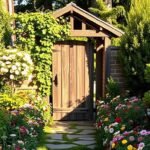Your home’s exterior tells a story before guests even step inside. Think of it as a hand-painted sign saying “come sit awhile” – achieved through thoughtful combinations of weathered textures, nostalgic accents, and greenery that feels collected over time. This approach works whether you’re updating a historic property or adding character to newer construction.
The magic lies in blending practicality with personality. A mismatched collection of thrifted planters or salvaged architectural pieces creates visual interest, while durable modern materials ensure longevity. Discover how repurposed treasures like galvanized troughs or antique can become starring features in your landscape design.
You’ll learn to balance structured elements with loose, flowing plant arrangements that soften edges. Even small touches – like solar-powered lanterns tucked among herbs or a vintage bench under climbing roses – build layers of warmth. These details work together to create spaces that feel lived-in rather than perfectly polished.
This guide focuses on adaptable solutions for various architectural styles. Whether you’re enhancing a ranch house or a suburban home, you’ll find ways to incorporate time-tested design principles. Let’s explore how intentional choices in materials, layout, and plant selection can turn any property into a neighborhood standout.
Enhancing Curb Appeal with a Welcoming Cottage Vibe
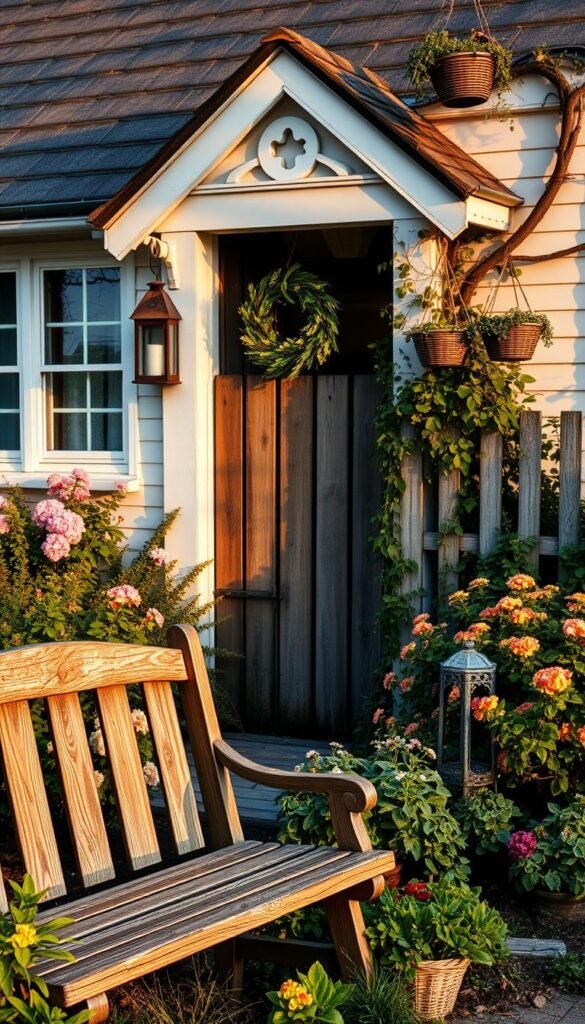
The moment visitors approach your property, their eyes search for clues about what lies beyond. A front entry that whispers “you belong here” starts with clear visual cues – not a garage dominating the view or shrubs swallowing your doorway. Nearly 68% of real estate agents say strong curb appeal increases buyer interest, but its true value lies in daily enjoyment.
Why First Impressions Matter
Your house communicates before you speak. Overgrown plants hiding windows or confusing pathways create subconscious tension. Prioritize sightlines to your front door – it’s the handshake of your home. Frame it with symmetrical planters or flanking shrubs to guide the eye naturally.
Consider this comparison of effective design choices:
| Design Element | Common Issue | Cottage Solution |
|---|---|---|
| Pathway | Straight concrete slab | Curved flagstone with creeping thyme |
| Lighting | Harsh floodlights | Solar-powered lanterns on shepherd hooks |
| Planters | Plastic containers | Repurposed galvanized troughs |
Incorporating Vintage and Time-Honored Details
Authentic charm comes from materials that age gracefully. Use reclaimed wood for address plaques or install a salvaged iron gate as a trellis base. These elements suggest history, even in newer homes.
Mix eras intentionally – pair antique doorknockers with modern smart locks. This balance keeps your entry functional while radiating warmth. Remember: chipped paint on a bench tells stories; peeling paint on your front door just looks neglected.
Transforming a Cottage Front Garden: Tips for Welcoming Entrance Appeal
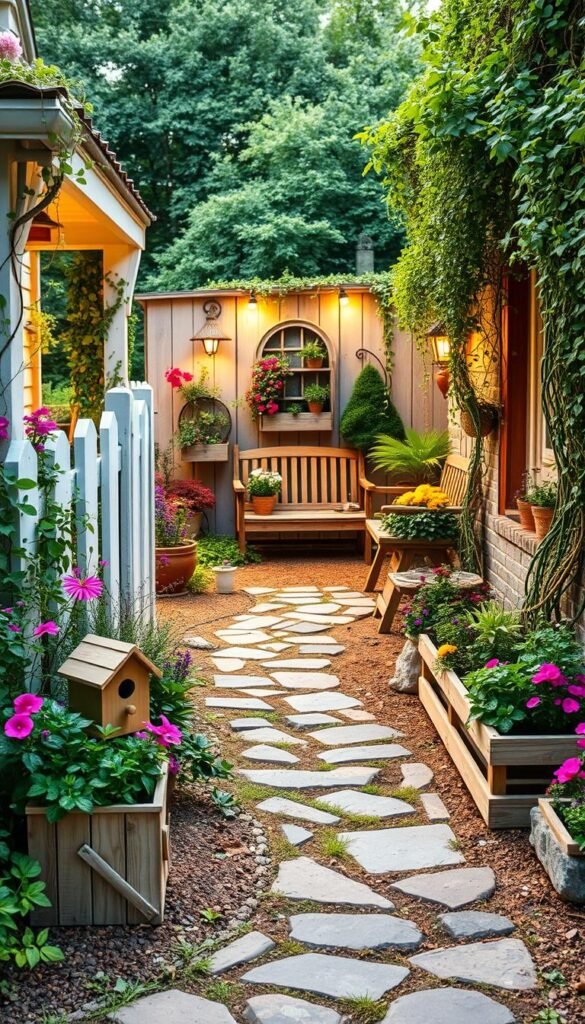
Your property’s potential often hides in plain sight. Years of DIY experiments reveal that modest changes—like swapping modern trim for chunky moldings—can trick the eye into seeing decades-old charm. One homeowner’s proudest moment? A guest mistook their 1990s ranch for a 1920s bungalow after weekend upgrades.
DIY Projects to Reimagine Your Front Yard
Start with your home’s “face”—windows and entryways. Replacing narrow trim with wider boards (6-8 inches) adds instant heft. Remove plastic shutters entirely or replace them with functional wooden versions. A wood porch built over a concrete stoop creates depth, especially when paired with reclaimed brick steps.
Pathways matter more than you think. Replace straight walkways with curved flagstone paths edged with thyme or moss. This softens rigid lines and invites exploration. For garages that dominate the view, train climbing roses on trellises to blur harsh edges.
Simple Upgrades to Boost Home Curb Appeal
Prioritize changes guests notice first. Paint your front door a heritage hue like sage green or buttery yellow. Swap generic house numbers for vintage-style metal plaques. Install motion-activated sconces with black metal finishes—they’re modern but feel timeless.
Even small tweaks create big impact. Replace builder-grade exterior lights with lantern-style fixtures. Add window boxes filled with trailing ivy and petunias. For budget-friendly landscaping ideas, divide perennials from other garden areas instead of buying new plants.
Creative Landscaping and Plant Selection Ideas
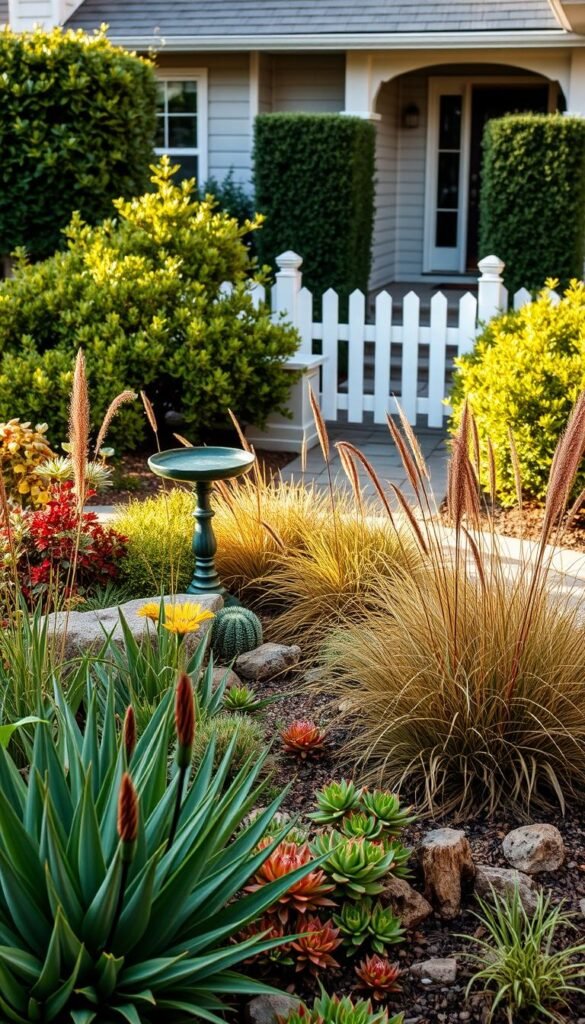
A well-planned garden acts like a living welcome mat, inviting guests with color and life. You don’t need vast space – even compact areas shine when you mix smart plant choices with strategic design. Focus on varieties that thrive with minimal effort while delivering maximum curb appeal.
Choosing Low-Maintenance and Seasonal Plants
Start with evergreen anchors like boxwood or arborvitae. These shrubs maintain structure year-round and need only annual pruning. For shady spots, hostas and hydrangeas offer lush foliage with modest water needs. Sunny areas? Try drought-tolerant sedum or Knock Out roses that bloom for months.
Fill gaps with seasonal color using marigolds or petunias. As one gardener notes: “Annuals are my secret weapon – $20 in six-packs gives me fireworks from May to frost.” Use soaker hoses beneath mulch to simplify watering, especially if you’re exploring patio container gardening alongside your landscape.
Using Color and Texture for Visual Impact
Layer plants like a pro by combining heights and textures. Pair feathery grasses with broad hosta leaves, then add delicate cosmos flowers. This creates interest even when blooms fade. Stick to 3-4 repeating colors for cohesion – soft purples, yellows, and whites work beautifully in cottage-style spaces.
Consider this plant combination guide:
| Season | Texture | Color Source |
|---|---|---|
| Spring | Fine (Ferns) | Tulips |
| Summer | Bold (Hosta) | Daylilies |
| Fall | Grassy (Sedum) | Mums |
Space plants using the “mature size” rule – no crowding! Proper spacing reduces disease risk and lets each specimen shine.
Designing an Inviting Front Door and Entryway
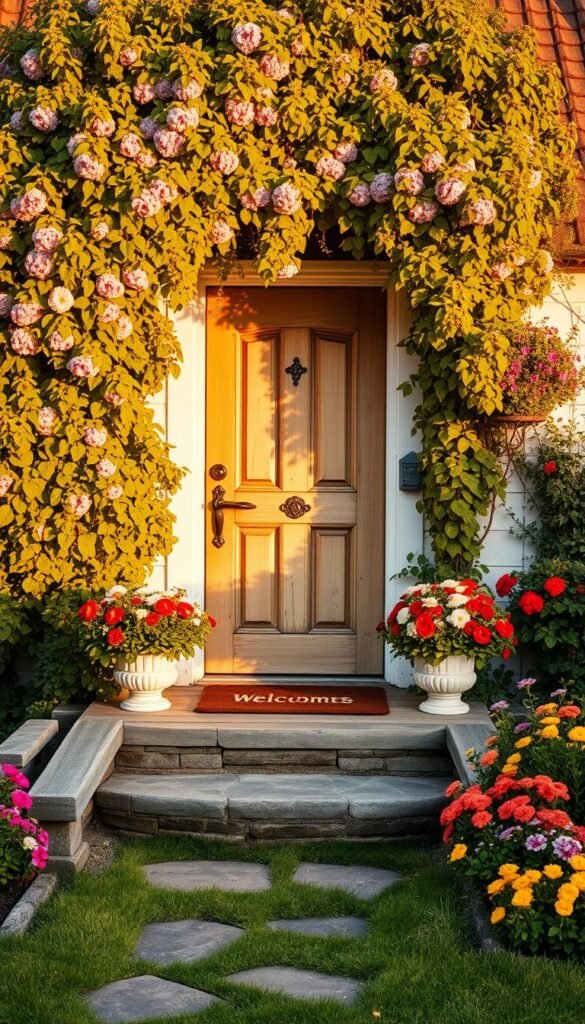
Your entryway sets the tone for your entire property. Think of it as a handcrafted invitation that balances charm with purpose. With smart upgrades, you can turn this space into a memorable focal point that boosts curb appeal and reflects your personal style.
Painting Techniques and Trim Enhancements
A fresh coat of paint works wonders. Choose a contrasting hue for your front door – deep navy against white siding or crimson red with stone accents. One homeowner shares: “Our sunflower-yellow door gets more compliments than our new roof!” Use exterior-grade paint and apply two thin coats for lasting results.
Upgrade window trim for instant character. Replace skinny moldings with 6-inch boards using basic tools. This $50 project makes newer construction look like it’s weathered decades gracefully. Sand edges lightly for a timeworn feel.
Decorative Accents and Functional Fixtures
Combine beauty and practicality with these elements:
- Oversized planters filled with lavender or boxwood
- Vintage-style house numbers mounted on reclaimed wood
- Lanterns with warm LED bulbs (motion-activated for safety)
Add a weathered bench beside your door for last-minute package drops or neighborly chats. Keep pathways clear – sweep weekly and power wash annually. Update your light fixture to something with visible bulbs and black metal finishes for cottage authenticity.
| Builder-Grade | Cottage-Style | Impact |
|---|---|---|
| Aluminum storm door | Full-view glass panel | Shows off door color |
| Plastic address plaque | Hand-forged metal numbers | Adds artisan charm |
| Generic porch light | Gooseneck barn light | Enhances architectural lines |
Incorporating Hardscaping and Outdoor Features
The bones of your outdoor space shape its charm as much as your plant choices. Strategic hardscaping creates functional beauty that frames your home while guiding foot traffic. Let’s explore how to blend structure with nature for spaces that feel both intentional and inviting.
Porch, Pathway, and Pergola Inspirations
Even a modest porch makes a difference. Extend posts 2 feet beyond your doorframe to create instant depth. Top concrete steps with reclaimed wood decking for warmth. Add railings with planter hooks to merge structure with greenery.
Curved walkways slow visitors, letting them appreciate your landscape. Use salvaged brick or irregular flagstone for paths that look decades old. Edge them with creeping thyme or dwarf mondo grass – these living borders soften edges naturally.
Pergolas offer vertical interest without full roofs. Attach one to your garage or entryway, then train jasmine or clematis across the beams. This creates shade and fragrance while boosting curb appeal on a budget.
Balance hard materials with plants using these tricks:
- Flank stone steps with overflowing ferns
- Nestle weathered benches under climbing roses
- Use gravel beds around pavers for drainage and texture
For tight spaces, maximize every inch of your yard with vertical trellises or hanging baskets. Mix materials like aged copper planters beside rough-hewn stone walls. These contrasts add character while keeping your front yard clutter-free.

